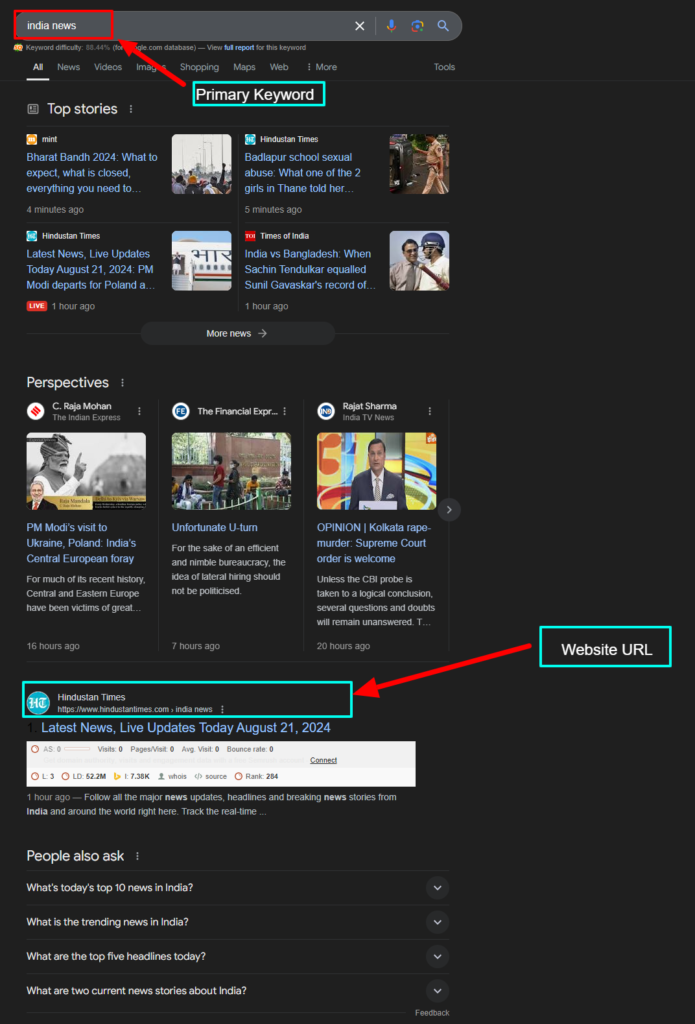SEO stands for Search Engine Optimization, which helps websites rank organically in search engine results pages. SEO assists websites in ranking on search engines like Google, Bing, Yahoo, and others. In other words, SEO (Search Engine Optimization) refers to using tactics and strategies to improve a website’s visibility and ranking in search engine result pages (SERP). The SEO goal is to increase organic traffic to the website, resulting in higher visibility, better crawlability, and more conversions.

In search engines, crawling is how web pages are discovered and scanned, while indexing organizes this information in their database. An effective SEO strategy helps to ensure that a website is accurately categorized and ranked, allowing it to appear in relevant search results and attract organic traffic.
According to various authoritative sources, these are some definitions of SEO:
• Wikipedia: Search engine optimization (SEO) is the process of improving the quality and quantity of website traffic to a website or a web page from search engines. SEO targets unpaid traffic rather than direct traffic or paid traffic.
• Moz: SEO stands for “search engine optimization.” It is the practice of increasing both the quality and quantity of website traffic, as well as exposure to your brand, through non-paid (also known as “organic”) search engine results.
• HubSpot: SEO is the process of optimizing your website to rank higher on search engine results pages (SERPs) to drive more traffic.
• Yoast: SEO is the practice of optimizing websites and web pages to rank higher in search engines such as Google.
• Neil Patel: SEO stands for search engine optimization, which is the practice of increasing the quantity and quality of traffic to your website through organic search engine results.
• Ahrefs: SEO is the practice of optimizing your web pages to rank higher in search engines like Google, Bing, and Yahoo. It also involves making changes to your website design and content to make it more appealing to a search engine.
• Search Engine Journal: SEO is the art and science of driving targeted website traffic to your site from search engines.
• Backlinko: SEO is the practice of optimizing your web pages to make them reach a high position in Google or other search engines’ organic search results.
• SEMrush: SEO is the set of practices designed to improve the appearance and positioning of web pages in organic search results.
Example:
1. “My website is healthline.com, and the primary keyword is ‘health news.’ You can see the screenshot showing our website ranking in position 1 on the SERP.”

2. “My website is hindustantimes.com, and the primary keyword is ‘India news.’ You can see the screenshot showing our website ranking in position 1 on the SERP.”

After viewing both screenshots, you can see the power of SEO (Search Engine Optimization). This is just the basic information about SEO. Small and large business owners use SEO for business promotion, selling or buying products, advertising, events, etc. Now, you might wonder, “How do SEO practitioners get website keywords to the top position in the SERP?” This is the first question that comes to mind when we don’t yet understand the power of SEO. When I first learned about SEO eight years ago, I had the same question. But after exploring various blogs, I found the answer. “SEO Techniques”
SEO Practitioners use different types of SEO Techniques, including:
- On-Page SEO Techniques: This SEO technique may work on a page-by-page basis of the website and focuses on content quality, keyword placement in website content, URL structure, image optimization, internal linking, external linking, geotagging (for local search), and more.
- Technical SEO Techniques: This SEO technique may work on a domain-wide basis, involving the optimization of website structure, page speed, HTTPS implementation, schema markup, canonical tags, 301 redirects, website crawlability, Google Analytics, Google Search Console, and more.
- Off-Page SEO Techniques: This SEO technique may work on a targeted keyword basis, including keyword research, bookmarking submissions, image submissions, classified submissions, local listing submissions, guest post submissions, profile creation, Google My Business optimization, blog comments, forum submissions, and more.
(Note: It is possible for a page to target multiple keywords, each optimized within a different section or element, maximizing its ability to rank for a wide variety of search terms.)
Core Elements of SEO
Audience: The specific people you’re targeting with your marketing, based on their behaviors and characteristics. This influences the type of content you create.
Searcher Intent: The reason someone is searching online. It can be to find information, navigate to a website, purchase, or research products/services.
Keywords: The words or phrases people type into search engines. These are crucial for tailoring your website content to what people seek.
Meta Description: A short description of what a webpage is about. This appears in search engine results and can help improve your page’s visibility.
Content: Everything on your website, including text, images, and videos. Optimizing this content is key to improving your search rankings.
Backlinks: Links to your website from other sites. They signal to search engines that your site is credible and relevant.
Site Architecture: How your website is structured. A well-organized site helps users find what they need and makes it easier for search engines to understand your content.
Site Speed: How quickly your website loads and responds. Faster sites offer a better user experience and can rank higher in search results.
Schema: A way of organizing and tagging your content so that search engines can understand it better, which can lead to more detailed search result listings.
